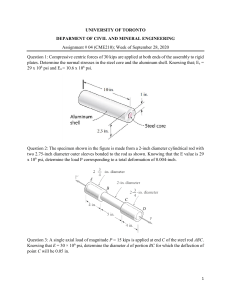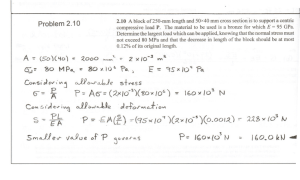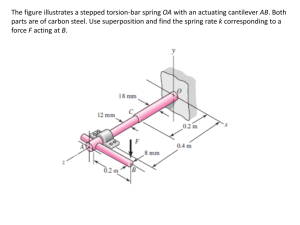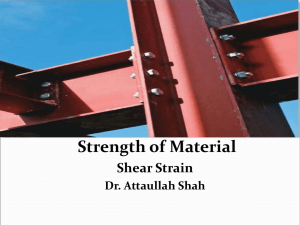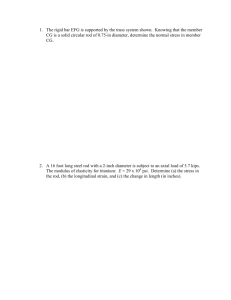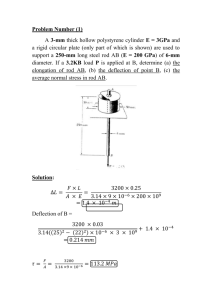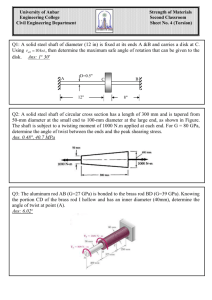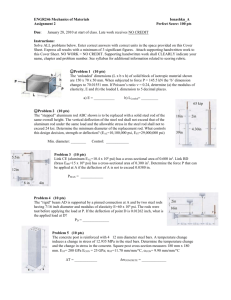HW 2
advertisement
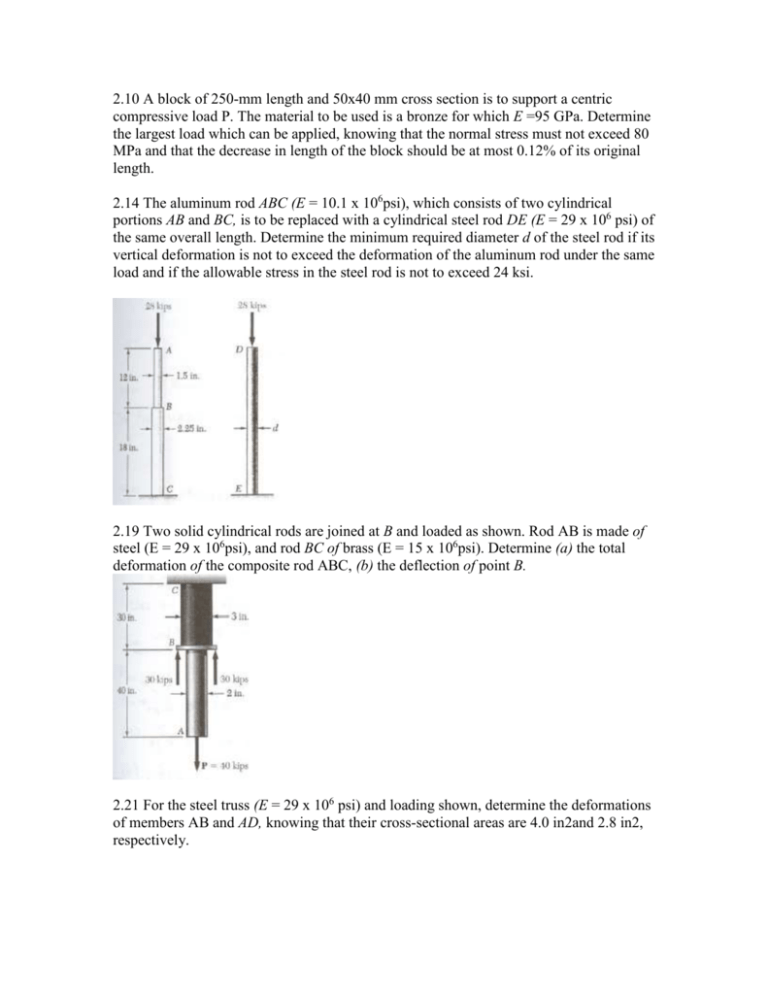
2.10 A block of 250-mm length and 50x40 mm cross section is to support a centric compressive load P. The material to be used is a bronze for which E =95 GPa. Determine the largest load which can be applied, knowing that the normal stress must not exceed 80 MPa and that the decrease in length of the block should be at most 0.12% of its original length. 2.14 The aluminum rod ABC (E = 10.1 x 106psi), which consists of two cylindrical portions AB and BC, is to be replaced with a cylindrical steel rod DE (E = 29 x 106 psi) of the same overall length. Determine the minimum required diameter d of the steel rod if its vertical deformation is not to exceed the deformation of the aluminum rod under the same load and if the allowable stress in the steel rod is not to exceed 24 ksi. 2.19 Two solid cylindrical rods are joined at B and loaded as shown. Rod AB is made of steel (E = 29 x 106psi), and rod BC of brass (E = 15 x 106psi). Determine (a) the total deformation of the composite rod ABC, (b) the deflection of point B. 2.21 For the steel truss (E = 29 x 106 psi) and loading shown, determine the deformations of members AB and AD, knowing that their cross-sectional areas are 4.0 in2and 2.8 in2, respectively. 2.26 The length of the 2-mm-diameter steel wire CD has been adjusted so that with no load applied, a gap of 1.5mm exists between the end B of the rigid beam ACB and a contact point E. Knowing that E = 200 GPa, determine where a 20-kg block should be placed on the beam in order to cause contact between B and E. 2.29 Determine the deflection of the apex A of a homogeneous paraboloid of revolution of height h, density ρ, and modulus of elasticity E, due to its own weight. 2.35 An axial centric force of magnitude P = 450 kN is applied to the composite block shown by means of a rigid end plate. Knowing that h = 10 mm, determine the normal stress in (a) the brass core, (b) the aluminum plates. 2.39 Two cylindrical rods, one of steel and the other of brass, are joined at C and restrained by rigid supports at A and E. For the loading shown and knowing that Es = 200 GPa and Eh = 105 GPa, determine (a) the reactions at A and E, (b) the deflection of point C. 2.46 The rigid bar AD is supported by two steel wires of 1~-in. diameter (E = 29 x106psi) and a pin and bracket at D. Knowing that the wires were initially taught, determine (a) the additional tension in each wire when a 220-lb load P is applied at D, (b) the corresponding deflection of point D. 2.48 The assembly shown consists of an alwninum shell (Ea= 70 GPa, αa= 23.6 x10-6/°C) fully bonded to a steel core (Es = 200 GPa, αs = 11.7 x 10-6/°C) and is unstressed at a temperature of 20°C. Considering only axial deformations, determine the stress in the aluminum shell when the temperature reaches 180°C. 2.57 Determine (a) the compressive force in the bars shown after a temperature rise of 180°F, (b) the corresponding change in length of the bronze bar. 2.68 A fabric used in air-inflated structures is subjected to a biaxial loading that results in normal stresses σx= 120 MPa and σy = 160 MPa. Knowing that the properties of the fabric can be approximated as E =87 GPaand v= 0.34, determine the change in length of (a) side AB, (b) side BC, (c) diagonal AC. 2.78 A vibration isolation unit consists of two blocks of hard rubber with a modulus of rigidity G = 2.75 ksi bonded to a plate AB and to rigid supports as shown. Denoting by P the magnitude of the force applied to the plate and by δ the corresponding deflection. determine the effective spring constant, k = P/δ, of the system. 2.94 Two holes have been drilled through a long steel bar that is subjected to a centric axial load as shown. For P = 32 kN, determine the maximum value of the stress (a) at A, (b) at B. 2.105 Rod AB is made of a mild steel that is assumed to be elastoplastic with E =200 GPa and σy= 345 MPa. After the rod has been attached to the rigid lever CD, it is found that end C is 6 mm too high. A vertical force Q is then applied at C until this point has moved to position C’. Determine the required magnitude of Q and the deflection δ1 if the lever is to snap back to a horizontal position after Q is removed. 2.109 Two tempered-steel bars, each 3/16-in. thick, are bonded to a 1/2-in. mild-steel bar. This composite bar is subjected as shown to a centric axial load of magnitude P. Both steels~ elastoplastic with E = 29 X 106psi and with yield strengths equal to 100 ksi and 50 ksi, respectively, for the tempered and mild steel. The load P is gradually increased from zero until the deformation of the bar reaches a maximum value δm=0.04 in. and then decreased back to zero. determine (a) the maximum value of P, (b) the maximum stress in the tempered-steel bars, (c) the permanent set after the load is removed. 2.120 Bar AB has a cross-sectional area of 1200 mm2 and is made of a steel that is assumed to be elastoplastic with E = 200 GPa and σy= 250 MPa. Knowing that the force F increases from 0 to 520 kN and then decreases to zero, determine (a) the permanent deflection of point C, (b) the residual stress in the bar. 2.130 Knowing that E =29 X 106 psi, determine (a) the value of 0 for which the deflection of point B is down and to the left along a line forming an angle of 36° with the horizontal,(b) the corresponding magnitude of the deflection of B.
